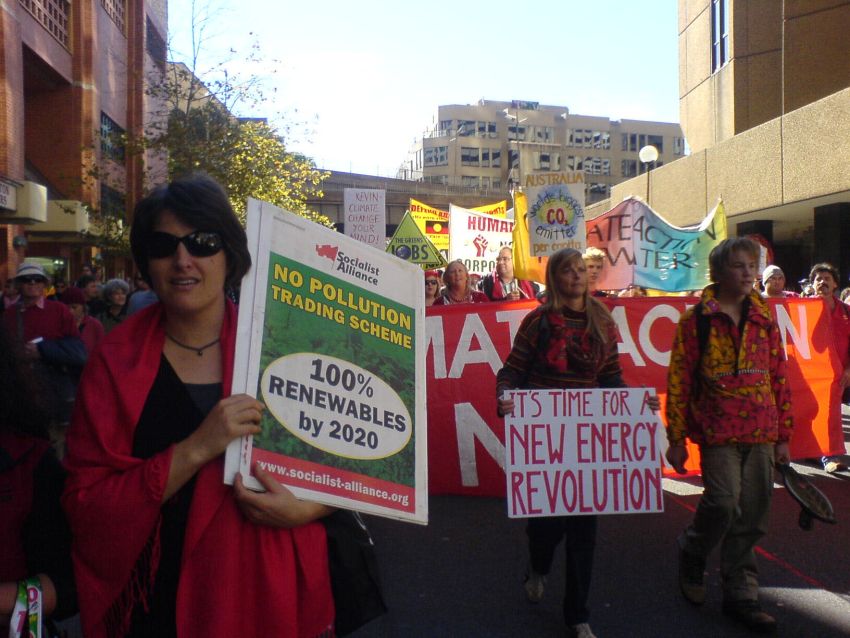
As it stands, the carbon tax proposed by the federal Labor government and the Greens is perfect material for a right-wing scare campaign. But it offers very little real action to cut emissions.
The tax, which is designed to turn into a fully-fledged carbon trading scheme within six years, raises some dilemmas for climate action campaigners.
Despite the policy's weaknesses, pressure is building on the climate movement to support the tax plan to counter the anti-tax campaign led by the Liberal party and the fossil fuel lobby.
So should the movement support the tax but demand a rising carbon price to encourage investment in renewable energy? That’s not a good idea, says climate research group Beyond Zero Emissions (BZE).
In a February 28 briefing paper titled “Carbon Pricing — Will it benefit renewable energy?” BZE said this would be “a flawed strategy".
BZE’s modelling showed that a price on carbon between $25 and $70 a tonne “will inevitably lead to a large switch to gas-fired power, with minimal benefits to renewable energy”.
Modelling by the Canberra-based Climate Institute adds weight to BZE’s conclusions about natural gas. But unlike BZE, it welcomes a gas boom.
The Climate Institute’s Will McGoldrick told The Age on March 5: “With a strong carbon price [of about $50 a tonne] you will see some coal shut down and gas being built, and you get more jobs than you have today — that's the point we are trying to make. The role the carbon price plays is in shifting the existing industry from coal to gas.”
Climate change minister Greg Combet confirmed this is the government’s plan in a March 9 Lateline interview.
“For baseload electricity generation it will be gas-fired electricity that we see emerge, and for that investment to be committed, we need a carbon price in the economy,” he said.
Gas is the opposite of “clean energy” and shifting to gas is no answer to the climate crisis.
A 2010 study by Cornell University’s Robert Howarth estimated that emissions from the US natural gas industry — from extraction to burning — are about as high as emissions from burning high quality steaming coal.
And fossil fuels such as gas are hardly “transition fuels”, which pave the way for renewable energy. That’s like saying building new roads will one day help expand public transport.
To begin to make wind power cheaper than fossil fuels, BZE said the carbon price would need to be at least $70 a tonne. But “for baseload technologies such as concentrating solar thermal, the game changer we need to replace coal and gas, you would need in excess of $200/tonne for initial plants”.
BZE said the kind of carbon price the Climate Institute supports “will raise electricity prices while doing little to support renewable energy investment”.
However, BZE said it supports a low carbon price of between $10-$20 a tonne if it is combined with other climate policies. It says the low price will limit electricity price rises and still discourage investment in new coal-fired power stations, without helping gas.
BZE concluded the climate movement’s strategy should therefore be to focus on a “carbon-pricing-plus framework that elevates ‘direct incentives’ such as Feed-in-Tariffs in the debate”.
Feed-in-tariffs, which pay renewable energy providers a higher price for the energy they produce, could play a useful role in promoting renewable energy and deserve support.
But it is necessary to go beyond BZE’s “carbon-pricing-plus” strategy in responding to the Labor/Greens carbon tax.
The big problem is that the proposed carbon tax is not really a tax — at least not for long. It’s actually a carbon trading scheme in slow motion. Combet stressed this point on March 9: “But let me also be perfectly frank with you: what we have announced is an emissions trading scheme.”
Once carbon trading is in place, all talk of a stable carbon price, high or low, becomes meaningless.
The price will be in the hands of the energy companies, traders and big financial corporations, who can game the market, avoid emissions cuts and manipulate the price to suit themselves. This has been the case with carbon trading in Europe and the US.
Given this, the best strategy is to take an independent position and stand against the proposed scheme and the frenzied campaign of the Liberals and the fossil fuel lobby.
For the climate movement, this would mean taking a similar position that it took on the former Rudd government’s flawed Carbon Pollution Trading Scheme.
It’s crucial we keep building support for the most important climate measures: public investment in renewables and regulation to phase out fossil fuels.
The right-wing crusade against the Labor/Greens carbon deal combines four main things: climate change denial, corporate greed, countless lies and an element of truth.
Because when Liberal leader Tony Abbott says the tax won’t do much to cut emissions but will raise living costs for working people he’s not wrong, even if he is manipulating the point for his own purposes.
That’s an ugly fact the grassroots climate action movement has to come to grips with.